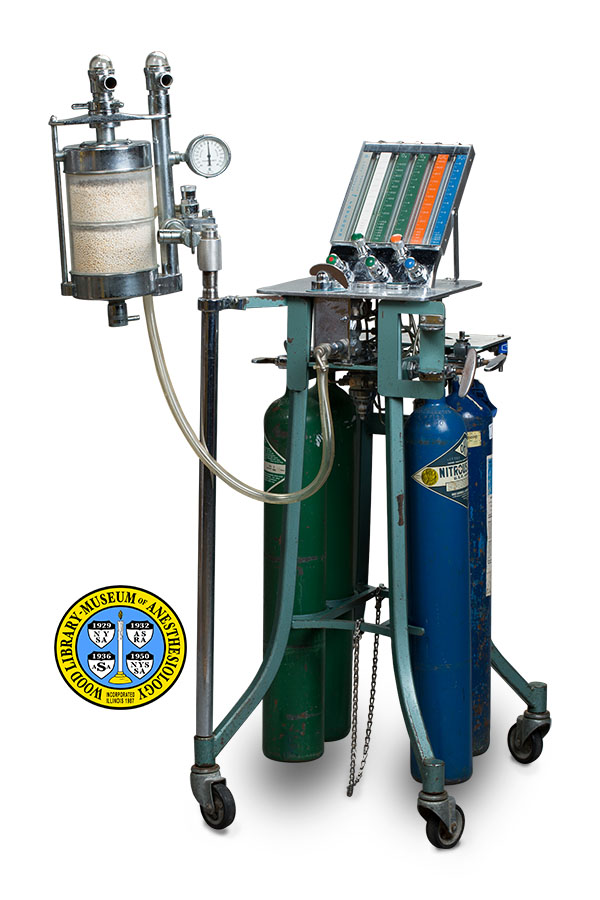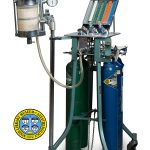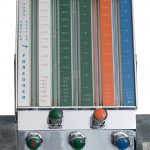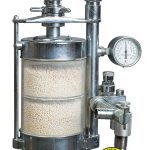Foregger Eiffel Model
The Model E, or Eiffel Model, was named for its resemblance to the famous Eiffel Tower in Paris, France. This machine was made in New York by the anesthesia equipment manufacturer, Foregger. It was equipped with Foregger's Copper Kettle Vaporizer and its integrated safety valve, which were introduced in 1955. The Copper Kettle could be calibrated for use with any one of several different liquid anesthetics. The safety valve allowed the breathing circuit to be quickly flushed with oxygen in case of need. The vaporizers have been removed from the example shown here.
The Eiffel Model was marketed from 1957 to 1962. A stripped-down modification of the Foregger Texas Model, it had an economical, open stand rather than the usual cabinet. A rectangular hand-grip on the front made it easier to move. The Eiffel also had an inclined bank of flowmeters, rather than the typical upright flowmeters. Each flowmeter tube monitored one of the gases connected to the machine, showing which gases were in use and the rate at which they were flowing to the patient. These gases were oxygen, and a choice of either nitrous oxide or cyclopropane. According to the manufacturer, the angle of the flowmeters provided uniform air-flow resistance for the full length of each tube, and did not require a leveling device to ensure accuracy.
Catalog Record: Foregger Eiffel Model Eiffel Model
Access Key: apob
Accession No.: 1992-08-07-2
Title: Model E / Foregger.
Corporate Author: Foregger Company.
Title variation: Alt Title
Title: Foregger Eiffel model.
Publisher: Roslyn Heights, New York : Foregger Company ; [between 1956 and 1965].
Subject: Anesthesia, Inhalation – instrumentation.
Subject: Anesthesia Machines.
Subject: Cyclopropane.
Subject: Oxygen.
Subject: Nitrous Oxide.
Note Type: General
Notes: The title is taken from the object. The alternate title is taken from the manufacturer’s catalog.
The first year in the date range is based on the absence of the Eiffel Model from Foregger’s 1956 catalog. The second year in the date range is based on the last description of it published by the manufacturer.
Note Type: General
Notes: The object is described from the point of view of an operator who is facing the controls.
The short physical description gives the maximum dimensions, with the wheels turned outward, with the absorber extension pole raised to its greatest height, and with the absorber fully extended to the right of the machine.
The object was married to cylinders and pop-off valves from the parts collection, for purposes of photography.
Note Type: Citation
Notes: Dornette WHL, Brechner VI. Instrumentation in Anesthesiology. Philadelphia: Lea & Febiger, 1959:157.
Note Type: Citation
Notes: Foregger, Richard. Death of a Company, Second Edition. Milwaukee: Richard Foregger, 2000.
Note Type: Citation
Notes: Foregger Company. Catalog No. 14. New York: The Foregger Company, 1956.
Note Type: Citation
Notes: Foregger Company. Catalog No. 15. New York: The Foregger Company, 1958:9 and 29.
Note Type: Citation
Notes: Foregger Company. Catalog 16: Foregger Apparatus for Anesthesia Oxygen and Extracorporeal Circulation. Roslyn Heights, Long island, New York: The Foregger Company, 1960:17.
Note Type: Citation
Notes: Foregger Company. Catalog 16: Foregger Apparatus for Anesthesia Oxygen and Extracorporeal Circulation. Roslyn Heights, Long island, New York: The Foregger Company, 1960:17.
Note Type: Citation
Notes: Foregger Company. Catalog 17: Foregger Apparatus for Anesthesia Oxygen and Extracorporeal Circulation. Roslyn Heights, Long island, New York: The Foregger Company, 1962:9.
Note Type: Citation
Notes: Foregger Company File. Archives. Located at: Wood Library-Museum of Anesthesiology, Schaumburg, Illinois.
Note Type: Citation
Notes: Shields JRS. Handbook of the practice of anesthesia. St. Louis: Mosby, 1963:22-23.
Note Type: Physical Description
Notes: One anesthesia machine; The frame has an A shape with curved legs rising to a small tabletop; The frame is enameled in the color named by the manufacturer “Hammertone Blue”; The machine alone, with its fixed pole, measures 114 x 55 x 61 centimeters; A removable extension pole is inserted into the fixed pole, and can be raised or lowered by depressing a button at the head of the fixed pole; The extension pole holds the absorber; The extension pole can be turned 360 degrees within its socket, although the attached absorber will prevent a full rotation when it is set at a height that would bring it into contact with the machine; With the absorber set at its lowest point, the height of the machine is 122 centimeters; One rectangular hand grip is mounted on the right side of the front of the machine;
The tabletop is 30.5 centimeters square; An oxygen flush valve is mounted on the tabletop near its left edge; This valve is marked: “KETTLE ON [new line] KETTLE OFF [new line] O2 FLUSH”; A label plate is mounted on the tabletop near its right edge; This label reads: “ATTENTION [new line] BEFORE OPENING THE CYLINDER VALVE MAKE SURE THAT [new line] CONTROL VALVE IS CLOSED. WATCH THE FLOWMETER [new line] WHILE CAREFULLY OPENING THE CYLINDER VALVE. [new line] WHEN FINISHING, USE CYLINDER VALVE FOR COMPLETE [new line] SHUT OFF. CLOSE THE CONTROL VALVE GENTLY. [new line] MODEL E SERIAL NO. 1639 [new line] THE FOREGGER CO., INC. [new line] ROSLYN HEIGHTS, NEW YORK”;
A flowmeter bank of five tubes is seated on the tabletop at an angle, so that the user must look down at it rather than straight ahead; The first tube, on the far left, has a silver labele to its left and a white label to its right; The left-hand, silver label is marked: “O2 THRU COPPER KETTLE FOREGGER”; The right-hand, white label is marked: “O2, -1000, -900, -800, -700, -600, -500, -400, -300, -200, -100, -80, -60, -40, -30, -20, -10”; The glass of the first tube is marked near the foot with the letter “B”; The second tube has a green label to its right, marked “O2”, with an upward arrow; The glass of the second tube is marked near the foot with the letter “B”; The third tube has a green label to its right, marked “-02, -10, -9, -8, -7,-6, -5,-4, -3, -2, -1, -500, -250”; The fourth tube has an orange label to its right, marked: “C3H6, -1000, -900, -800, -700, -600, -500, -400, -300, -200, -100, -80, -60, -40, -20”; The fifth tube, on the far right, has a blue label to its right, marked: “N2O -9, -8, -7, -6, -5, -4, -3, -2, -1, -800, -600, -400, -200”; The glass of the fifth tube is marked near the foot with the letter “A”; Five control knobs are mounted below the tubes; From left to right, these are color-coded: green, green, green with an orange spot in the center, orange, and blue; Each knob extends vertically from the bank;
There are three gauges affixed to the tabletop directly in front of the flowmeter bank; The gauge on the left has a green background, and is marked: “O, 500, 1000, 1500, 2000, 2500, 3000 [new line] USE NO OIL [new line] O2 [new line] FOREGGER [new line] UL”; The middle gauge has an orange background, and is marked: “0, 50, 100, 150, 200, 250, 300 [new line] C3H6 [new line] FOREGGER”; The gauge on the right has a blue background, and is marked: “0, 250, 500, 750, 1000, 1250, 1500 [new line] N2O [new line] FOREGGER”;
Note Type: Physical Description
Notes: There are two cylinder yokes on the left side of the machine, each labeled “O2”; There are two cylinder yokes on the right side of the machine, each labeled “N2O”; There is one yoke on the back of the machine labeled “C3H6”; A shelf on the back of the machine, located below the tabletop, has marks and openings that indicate the former location of one large and one small Copper Kettle vaporizer; Mounted below this shelf are two connectors for wall gas supply systems; The connector on the left is marked “O2” and that on the right is marked “N2O”;
A built-in pole for the carbon dioxide absorber is seated in the left front foot of the machine, just above that wheel; The top of the pole is fixed by a bar that extends from the tabletop; The absorber has two transparent plastic canisters, each enclosed in a wire frame; The absorber is marked with the serial number “3885”; The gauge on the absorber is marked: ‘NEG 40, 35, 30, 25, 20, 15, 10 5, 0″ [new line] POS 5, 10, 15, 20, 25, 30, 35, 40 [new line] FOREGGER [new line] Cm H2O [new line] U. S. Gauge [new line] 26209″; The absorber lacks both of its pop-off valves; Each of the rims meant to hold a pop-off valve is marked: “INFLATION – FOREGGER”.
Note Type: Reproduction
Notes: Photographed by Mr. Steve Donisch, November 16, 2016.
Note Type: Acquisition
Notes: Gift of Charles Gamble, M.D.
Note Type: Historical
Notes: The Model E, also called the Eiffel Model, was named for its resemblance to the famous Eiffel Tower in Paris, France. It was made in New York by the Foregger Company, an anesthesia equipment manufacturer. This model was equipped with Foregger’s Copper Kettle Vaporizer and its integrated safety valve, which were introduced in 1955. The Copper Kettle could be calibrated for use with any one of several different liquid anesthetics. The safety valve allowed the breathing circuit to be quickly flushed with oxygen in case of need. Purchasers could request the addition of a second Copper Kettle vaporizer. The cataloged object once had both a 400 cc and a 200 cc vaporizer; these were removed at an unknown date.
The Eiffel Model had an economical, open stand rather than the usual cabinet with drawers. One or two rectangular hand-grips were mounted on the front of the machine, compensating for the lack of a large tabletop (in cabinet models, the rounded edges of the tabletop could be grasped to maneuver the machine.) The cataloged object has only one hand-grip. The Eiffel also had an inclined bank of ball-type flowmeters, rather than Foregger’s typical upright bank of rotameter flowmeters. Each flowmeter tube monitors one or more of the gases connected to the machine, showing which gases were in use and the rate at which the gases were flowing to the patient. These gases were oxygen, and a choice of either nitrous oxide or cyclopropane. According to the manufacturer, the angle of the flowmeters provided uniform air-flow resistance for the full length of each tube, and did not require a leveling device to ensure accuracy.
The cataloged object has a built-in pole that is seated in the left front foot of the stand; a bracket attaches the top of the pole to the tabletop. In the cataloged object, the pole carries a double-decker carbon dioxide absorber. The built-in pole appears only in Foregger’s 1962 catalog. Earlier illustrations of this model show only a bracket affixed to the left front leg of the stand.
The Eiffel Model does not appear in Foregger’s Catalog No. 14 (published in 1956). The earliest references found by the cataloger are advertisements published in 1957. The Eiffel Model appears in Foregger’s catalogs No. 15 (published in 1958), No. 16 (published in 1960) and No. 17 (published in 1962). No subsequent Foregger publications include any anesthesia machines. After the death of its founder, Richard von Foregger (1872-1960), the company changed hands several times, and was dissolved in 1983.
Note Type: Exhibition
Notes: Selected for the WLM website.




